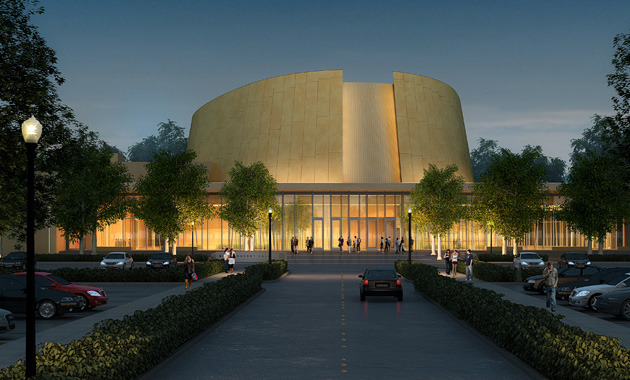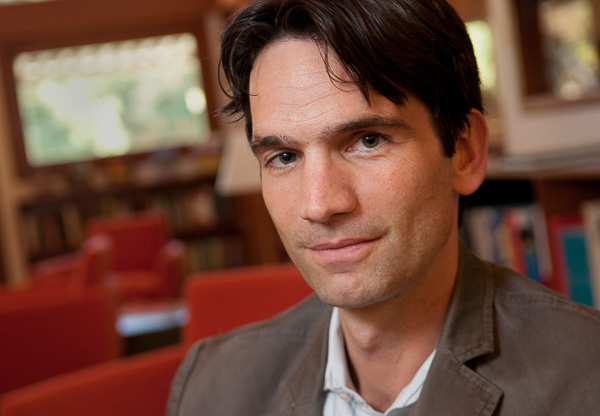

The 844-seat Bing Concert Hall is expected to be completed in summer 2012, with the first public performances in January 2013. (© Ennead Architects)
Arts Initiative
Arts Initiative makes arts more pervasive on Stanford campus
The ground breaking of the Bing Concert Hall in 2010 is evidence of the progress achieved in the arts at Stanford since the Arts Initiative was announced in 2006.
The initiative, designed to integrate the arts and creativity into every field of study, has built on Stanford’s ability to foster collaboration across disciplines and to create synergies between research and expression. It continues to support arts programs and increase the presence of the arts on campus.
The initiative is headed by Jonathan Berger, the Denning Family Provostial Professor, and Bryan Wolf, the Jeanette and William Hayden Jones Professor in American Art and Culture.
An arts district takes shape
The Bing Concert Hall represents a next step for the initiative as an arts district takes shape on the north part of campus. The district will centralize widely scattered resources for music, drama, dance, visual arts, film and creative writing.
Besides the concert hall, the new district will include the Frost Amphitheater, the Thomas Welton Stanford Art Gallery, the Iris & Gerald Cantor Arts Center, Memorial Auditorium and the new Burton and Deedee McMurtry Building, which will house the Department of Art and Art History.
“The Bing Concert Hall will be the first note for a long-range vision for the new arts district as you enter campus,” said University Architect David Lenox. “What will be nice about coming onto campus in the future is that you’ll know that the culture and arts are a complement to the medical, law, engineering, education, medicine and business components at Stanford.”
The Bing Concert Hall, key to that new district, is expected to be completed in Fall 2012. Named for Peter and Helen Bing, the 844-seat hall will host its first public performances in January 2013.
The concert hall is designed to be acoustically exceptional and able to accommodate a variety of performances, from world-renowned visitors to Stanford’s own community of faculty and student musicians—including the Stanford Symphony Orchestra and Symphonic Chorus, the Grammy-nominated St. Lawrence String Quartet, and the composers and researchers at the Center for Computer Research in Music and Acoustics, widely known for its iPhone and laptop orchestras. The concert hall also will be the primary venue for Stanford Lively Arts, whose 100 events a year bring in an audience of 30,000 annually.
Video: Bing Concert Hall Groundbreaking
Peter and Helen Bing join Stanford President John Hennessy to break ground for the new Bing Concert Hall on May 11, 2010.
A home in Humanities and Sciences

Matthew Tiews was named Stanford's first executive director of arts programs for the School of Humanities and Sciences. (L.A. Cicero)
Moving forward, the initiative will be administratively housed in the School of Humanities and Sciences, although it remains a university-wide effort. Matthew Tiews was appointed the first executive director of arts programs in 2010. Together with faculty members, Tiews will coordinate programs throughout the Arts Initiative, including the Stanford Institute for Creativity and the Arts (SiCa), Stanford Lively Arts, the Cantor Arts Center and the new Bing Concert Hall.
In the future, the initiative is expected to build on its successes, which include developing new undergraduate programs, creating graduate fellowships, hosting artists in residence, sponsoring arts programming for undergraduates and encouraging multidisciplinary research and teaching.
Among the other 2010 highlights of the Arts Initiative was programming sponsored under the theme “The Year of Art + Invention.”
SiCa, in particular, sponsored more than 65 events, 10 internships and eight graduate fellowships and awarded more than 110 grants to students, faculty and staff. Also sponsored by SiCa were 110 individual visiting artists and 12 ensembles, groups and companies participating in public performances, lectures, workshops, classroom activities and residential life. More than 1,000 arts events occurred on campus in 2009-10.
